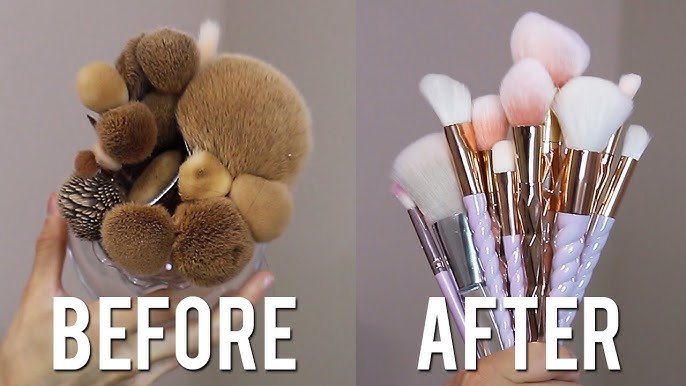Cleaning your makeup brushes regularly is essential not only for your skin’s health but also for preserving the life of your tools. Dirty brushes can harbor bacteria, old makeup, oil, and dead skin cells, all of which can contribute to clogged pores, breakouts, and patchy makeup application. The good news? You don’t need expensive brush cleansers or specialized tools. You can clean your brushes thoroughly using items already in your home.
In this guide, we’ll walk you through how to clean makeup brushes with household items, how often you should clean them, and how to dry them properly to avoid damaging the bristles.
Why You Should Clean Your Makeup Brushes
Before diving into the cleaning methods, it’s essential to understand why you should clean your brushes:
- Prevent Breakouts: Dirty brushes can transfer bacteria to your skin, leading to acne and irritation.
- Better Makeup Application: Clean brushes offer smoother, more even application.
- Prolong Brush Life: Regular cleaning prevents product buildup and helps maintain the shape and softness of bristles.
- Hygiene: Brushes that touch your face daily should be as clean as any personal hygiene item.
Household Items You Can Use to Clean Your Brushes
Here are common household items that are safe and effective for cleaning makeup brushes:
| Household Item | Purpose | Notes |
|---|---|---|
| Dish Soap | Breaks down oil and makeup | Prefer fragrance-free for sensitive skin |
| Olive Oil | Conditions natural bristles | Use sparingly to avoid residue |
| White Vinegar | Antibacterial properties | Use diluted, and rinse thoroughly |
| Baking Soda | Deodorizes and exfoliates | Ideal for deep cleaning |
| Baby Shampoo | Gentle on bristles | Best for natural hair brushes |
| Micellar Water | Lifts makeup residue easily | Suitable for light cleaning between deep washes |
Step-by-Step: How to Clean Makeup Brushes with Household Items
Follow these steps to deep-clean your brushes at home:
1. Gather Your Supplies
You will need:
- Dish soap or baby shampoo
- Olive oil (optional, for natural bristles)
- A small bowl or plate
- A clean towel
- Lukewarm water
2. Make the Cleaning Solution
For synthetic brushes:
- Mix a few drops of dish soap with lukewarm water in a bowl.
For natural hair brushes:
- Mix 2 parts baby shampoo with 1 part olive oil.
3. Wet the Brush
Run the brush bristles under lukewarm water, avoiding the handle. Water can weaken the glue that holds the bristles in place, so always hold the brush downward.
4. Lather the Bristles
Swirl the brush in your cleaning solution, gently massaging it to loosen product buildup. Use your fingers or the palm of your hand for deeper cleaning.
5. Rinse Thoroughly
Rinse under lukewarm water until the water runs clear. Be gentle and avoid soaking the entire brush.
6. Reshape and Dry
Gently squeeze out excess water with a clean towel. Reshape the bristles and lay the brushes flat on a towel, with the bristles hanging off the edge of a counter to air dry completely.
Bonus: Natural Disinfectant Rinse
For extra sanitation, especially for brushes used with liquid products:
- Mix 1 part white vinegar with 2 parts water.
- Dip the bristles in the solution for a few seconds.
- Rinse again with clean water and dry as usual.
How Often Should You Clean Your Brushes?
| Brush Type | Recommended Cleaning Frequency |
|---|---|
| Foundation/Concealer | Once a week |
| Powder/Blush Brushes | Every 1–2 weeks |
| Eye Brushes | Once a week |
| Lip Brushes | After every use |
| Sponges/Blenders | After every use or every 2–3 days |
Keeping a regular schedule helps prevent bacteria buildup and improves your overall skincare and makeup routine.
FAQs About Cleaning Makeup Brushes with Household Items
Can I use vinegar alone to clean my brushes?
While vinegar has antibacterial properties, it’s best used diluted and as a final rinse, not as the main cleaner. Always follow with a rinse of soap and water to remove the vinegar smell.
Is dish soap safe for my brushes?
Yes, dish soap is effective at cutting through oils and makeup residue. Just avoid those with harsh chemicals or added fragrances, especially if you have sensitive skin.
How do I dry makeup brushes properly?
Lay them flat with the bristles hanging off the edge of a counter. This ensures they keep their shape and prevents water from seeping into the handle.
Can I use shampoo instead of dish soap?
Absolutely. Baby shampoo or gentle, sulfate-free shampoos are great for natural bristles and delicate brushes.
How long does it take brushes to dry?
Depending on size and density, brushes can take anywhere from 6 to 12 hours to dry completely. It’s best to clean them in the evening and let them dry overnight.
Final Tips for Brush Maintenance
- Avoid harsh rubbing: Always be gentle when cleaning and reshaping.
- Don’t soak brushes: Especially avoid getting water into the ferrule (the metal part).
- Use a brush mat: If available, brush cleaning mats can speed up the cleaning process.
- Keep a routine: Consistency is key to brush hygiene.
Why Clean Brushes Matter for Overall Beauty
Your makeup routine isn’t just about the products you apply—it’s also about the tools you use. Clean brushes lead to better skin and smoother makeup results. If you’re investing in skincare and products like those in the Top 10 Beauty Supplements for Skin and Hair, then maintaining clean tools ensures you’re not undermining your progress.
By using simple items already in your kitchen or bathroom, you can clean your brushes effectively without spending money on specialized cleaners. A few minutes of care can save you from breakouts, extend the life of your brushes, and elevate your makeup game.


